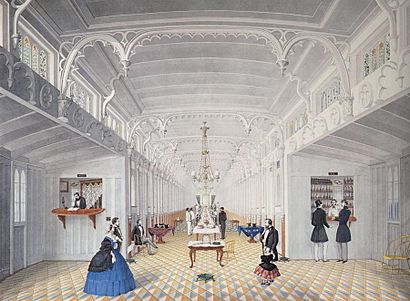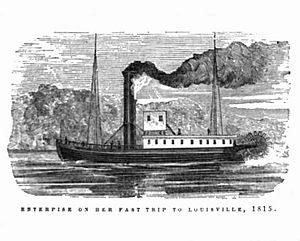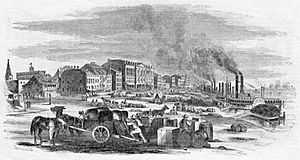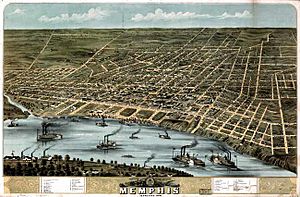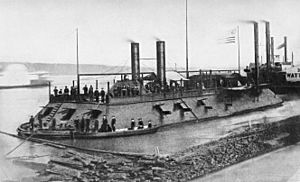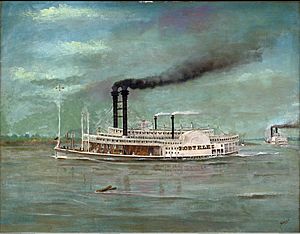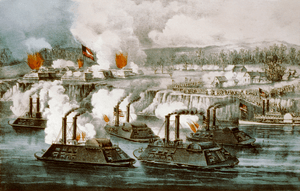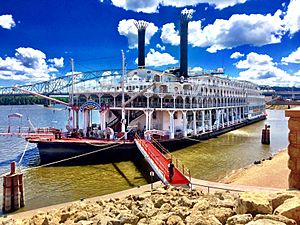Steamboats of the Mississippi facts for kids
Steamboats were super important in the 1800s for exploring and trading along the Mississippi River and its many branches. These amazing boats, powered by steam, could travel in shallow water and even go against strong river currents.
Later, when trains became popular, people started using them because they were faster. But steamboats still carried goods on the Mississippi River until the early 1900s. Even today, a few steamboats are still used for fun tourist trips!
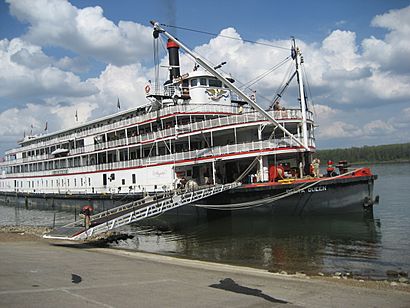
Contents
- The Mighty Mississippi River
- How Steamboats Began
- The Golden Age of Steamboats
- How Steamboats Were Built
- The Famous Natchez Steamboats
- Making the River Safer to Travel
- Important River Cities
- Mark Twain and the River
- Dangerous Boiler Explosions
- Rules and Regulations
- Showboats: Floating Theaters
- Steamboats in the Civil War
- After the Civil War: Barges Rise
- Trains Take Over
- The Rise of Barge Traffic
- The Great Flood of 1927
- Managing the Mississippi River
- End of the Steamboat Era
The Mighty Mississippi River
The Mississippi is one of the world's biggest rivers. It stretches about 3,860 kilometers (2,400 miles) if you include its longest branch, the Missouri River. The Missouri River starts in the Rocky Mountains and joins the Mississippi in Missouri. Other big rivers like the Ohio and Tennessee join it from the east, while the Arkansas, Platte, and Red River of Texas flow in from the west.
The Mississippi River itself begins at Lake Itasca in Minnesota. It flows through the middle of the country, forming borders for ten states. This huge river helped connect different parts of the country, making trade and culture grow.
How Steamboats Began
Steamboats became popular on the Mississippi thanks to new technology and big changes in the country. In 1803, the U.S. bought the huge Louisiana Territory from France. This meant the U.S. could expand west, opening up new areas for people and trade.
In 1801, a boat called the Charlotte Dundas in Scotland showed that steamboats could work. Then, in 1807, Robert Fulton's Clermont proved it again on the Hudson River in New York. Early steamboats were basically wooden barges with steam engines and paddles.
In 1811, the first steamboat for the Mississippi, called the New Orleans, was built in Pittsburgh. Fulton started a steamboat service between Natchez and New Orleans. After the War of 1812, New Orleans became a very important port at the mouth of the Mississippi River.
The Golden Age of Steamboats
The first steamboats on the Mississippi River, also known as Western Rivers steamboats, quickly improved. Here are some of the early important ones:
- New Orleans: Launched in 1811, this was the first steamboat on the Mississippi. It was a large side-wheeler.
- Comet: Built in 1813, it was smaller and used a new, lighter engine with a stern paddlewheel (at the back of the boat).
- Enterprise: Launched in 1814, this boat was much better for the Mississippi. It had a high-pressure engine and a single stern paddlewheel. It made an amazing trip from New Orleans all the way to Brownsville, Pennsylvania, going against the strong river currents for over 2,000 miles (3,200 km)!
- Washington: Built in 1816, this was the first steamboat with two decks. The top deck was for passengers, and the main deck held the boiler, leaving more space below for cargo. This design became the standard for Mississippi steamboats.
Steamboats were perfect for the growing United States during the time of President Andrew Jackson. In the 1810s, there were only about 20 steamboats on the river. But by the 1830s, there were over 1,200! They helped move goods like cotton, rice, timber, and tobacco from farms to cities. They also carried coal from Pittsburgh to New Orleans.
How Steamboats Were Built
Most steamboats were made of wood. They could be anywhere from 40 feet (12 meters) to nearly 300 feet (91 meters) long and 10 feet (3 meters) to 80 feet (24 meters) wide. They only needed about one to five feet of water when loaded, so people joked they could "navigate on a heavy dew."
These boats had strong internal supports called kingposts and iron trusses called hogchains to keep the hull from bending. A second deck, called the Texas Deck, was added for cabins and passenger areas. Everything was made of wood, including stairs, kitchens, and fancy sitting rooms. Many boats were decorated with beautiful wood carvings, velvet, and gold trim.
The wood-burning boilers were usually placed near the front-center of the boat to balance the weight. The engines were either in the middle or at the back, depending on if the boat had side paddlewheels or a single stern paddlewheel. Two rudders helped steer the ship.
On average, steamboats only lasted about five years. This was because their wooden hulls could get damaged, they weren't always maintained well, and fires or boiler explosions were common. Early trips up the Mississippi River could take three weeks. But later, with better pilots and more powerful engines, trips were much faster, sometimes taking only four days.
The Famous Natchez Steamboats
There were many steamboats named Natchez, each one a new version built after the last.
- The first Natchez was built in 1823. It carried famous people like Marquis de Lafayette, a French hero of the American Revolutionary War. It was destroyed by fire in 1835.
- Natchez VII was built in 1869. It was 301 feet (92 meters) long and could carry 5,500 bales of cotton. This boat became famous for its race against another steamboat, the Robert E. Lee, in 1870. The Robert E. Lee won the race from New Orleans to St. Louis in 3 days, 18 hours, and 14 minutes. The Natchez carried its usual cargo and stopped more often, but still finished only six hours later.
- The current Natchez (sometimes called Natchez IX) was built in 1975. It's a sternwheel steamboat based in New Orleans. It uses steam engines from a much older steamboat built in 1925! It also has a copper bell made from 250 melted silver dollars and a steam calliope (a musical instrument that plays with steam whistles). This Natchez has won the Great Steamboat Race every time it has competed.
Making the River Safer to Travel
In 1824, the U.S. government passed a law to improve navigation on the Ohio and Mississippi Rivers. The Army Corps of Engineers was given the job to remove sandbars and other obstacles. They also worked on two difficult spots on the upper Mississippi: the Des Moines Rapids and the Rock Island Rapids, where the river was shallow and rocky.
Eventually, a canal was built around the Des Moines Rapids in 1877 to make travel easier. The Army Corps of Engineers continues to work on keeping the rivers safe and navigable today.
Important River Cities
St. Louis: A Busy Port
St. Louis became a very important trade center. It was a key stop for people traveling west on trails like the Oregon and California trails. It was also a major supply point for steamboats on the Mississippi River. Rapids north of the city meant that many large boats couldn't go further north, making St. Louis a bustling northern port. By the 1830s, it was common to see over 150 steamboats at the St. Louis riverfront at once! By the 1850s, St. Louis was the second-largest port in the country, after New York.
Memphis: A Key Southern Port
Memphis was another big port on the Mississippi. During the American Civil War, both Union and Confederate forces fought for control of this important city. A naval battle was even fought on the river right above Memphis in 1862.
A local hero named Tom Lee, who couldn't swim, saved 32 people from drowning when the steamboat M.E. Norman sank in 1925. A park on the Memphis riverfront is named after him.
Mark Twain and the River
Many of the famous writer Mark Twain's stories are about or take place near the Mississippi River. His book Life on the Mississippi is about the river's history and his own experiences working on it. His most famous book, Adventures of Huckleberry Finn, is mostly a journey down the river. The river in his stories often means freedom and adventure.
Twain himself worked as a steamboat pilot on the Mississippi for a few years. He had to learn the river's changing paths very carefully. He studied 2,000 miles (3,200 km) of the Mississippi for two and a half years before getting his pilot's license in 1859. Sadly, his younger brother Henry died in 1858 when the steamboat Pennsylvania exploded.
Dangerous Boiler Explosions
Between 1811 and 1853, about 7,000 people died because of huge boiler explosions on steamboats. These explosions happened often because boilers were not built well and were operated unsafely.
Early steamboat boilers were made from many small pieces of iron joined together, which weren't very strong. Engineers often pushed the engines too hard, and there were no rules to make sure boats were maintained or inspected. This made explosions very common.
People still traveled by steamboat despite the danger because it was the best way to travel at the time. Boat operators weren't required to have insurance or pay for accidents, so they didn't have much reason to improve safety. It took many terrible accidents before things changed. One of the worst was the Sultana explosion in 1865, which killed at least 1,192 people, making it the deadliest maritime disaster in U.S. history.
Rules and Regulations
At first, there were no rules for steamboats. Some states tried to control who could operate steamboats on their waters. But this caused problems, especially when boats traveled between states.
After many disasters, the government finally started to act. The Steamboat Act of 1852 was a big step. It required boilers to be tested and to have safety valves. It also said that pilots and engineers needed to be licensed. This law helped make steamboat travel much safer over time.
Showboats: Floating Theaters
A showboat was like a traveling theater on the water. These barges, which looked like long, flat-roofed houses, were pushed by small tugboats. They couldn't have their own steam engines because that would take up too much space in the theater!
The first showboat, called the "Floating Theatre," was created in 1831. It traveled along the rivers, stopping to perform plays, music, and dances for people in different towns. Showboats became very popular, especially in the late 1800s, offering melodramas and vaudeville shows. As roads improved and cars became common, showboats slowly disappeared, but some became very large and colorful in the 1900s. Famous jazz musicians like Louis Armstrong even played on Mississippi River showboats.
Steamboats in the Civil War
The American Civil War also involved steamboats. Paddlewheelers were turned into warships, like the ironclad riverboats used in the Battle of Vicksburg. The USS Cairo is a surviving warship from that battle. Trade on the river stopped for two years because of a Confederate blockade. But when Union forces won control of the river, it was a big victory.
As mentioned before, the worst steamboat accident ever happened at the end of the Civil War. The steamboat Sultana exploded in April 1865, killing over 1,000 Union soldiers who were returning home from prison camps.
After the Civil War: Barges Rise
After the Civil War, passenger steamboats became even bigger and fancier. But for carrying goods, a new system developed: barges. Towboats (which are like tugboats for rivers) started pushing huge groups of barges lashed together. This gave them much more control than just pulling barges behind them. This system worked better with sternwheel boats.
Sand and gravel were dredged from the river bottom and loaded onto barges. By the 1850s, this method was common.
Trains Take Over
After the Civil War, railroads in the South were rebuilt and expanded. Trains became cheaper and faster than steamboats for moving goods and people over long distances. The first railroad bridge across the Mississippi River was built in 1856, connecting Davenport and Rock Island, Illinois. Steamboat owners saw railroads as a big threat to their business.
The Rise of Barge Traffic
Even though steamboats declined, river transportation didn't disappear. During World War I, trains couldn't handle all the transportation needs, so river barges became very important. The government invested a lot of money in building new barges and towboats.
Later, around the 1930s, diesel engines started to replace steam engines in towboats. Diesel engines needed smaller crews and were more efficient. By 1955, almost all towboats were diesel-powered. The old paddlewheels were replaced by screw propellers, which worked better with diesel engines.
Today, barge traffic is still very important on the Mississippi River. About 60% of U.S. grain exports travel by barge down the Mississippi to the Gulf of Mexico. Barges are a very safe and fuel-efficient way to transport goods. One barge can carry as much as 15 train cars!
The Great Flood of 1927
In 1927, the Mississippi River experienced a massive flood. Heavy rains caused the river to break through its levee system in 145 places. About 27,000 square miles (70,000 square kilometers) of land were flooded, some areas under 30 feet (9 meters) of water! This flood caused over $400 million in damages and killed 246 people in seven states. It was a huge disaster for the country.
Managing the Mississippi River
The Mississippi River Commission was created in 1879 to help improve the river. Their goals were to make the river channel deeper and safer for boats, prevent floods, and help trade.
After the Great Flood of 1927, the government passed the Flood Control Act of 1928. This law gave the Mississippi River Commission the job of controlling floods along the entire Mississippi River and its branches. They also work on improving navigation, stabilizing the riverbanks, and protecting the environment along the river.
The United States Army Corps of Engineers is a big part of this work. They are a federal agency that maintains over 12,000 miles (19,000 km) of inland waterways and operates 235 locks. They also work on flood protection across the country. For many years, the Corps had its own fleet of steam-powered boats, dredges, and cranes to do this work.
End of the Steamboat Era
The Great Depression, the huge increase in shipbuilding during World War II, and the rise of diesel tugboats brought an end to the main steamboat era. Diesel tugs needed fewer crew members, making steam towboats too expensive to operate. Many old steam vessels were taken apart.
Today, only a few paddlewheelers still run on steam power, like the Belle of Louisville, the Natchez, and the American Queen. These boats mostly offer tourist cruises. The Belle of Louisville is especially famous, becoming the first Mississippi River-style steamboat to reach 100 years old in 2014!


